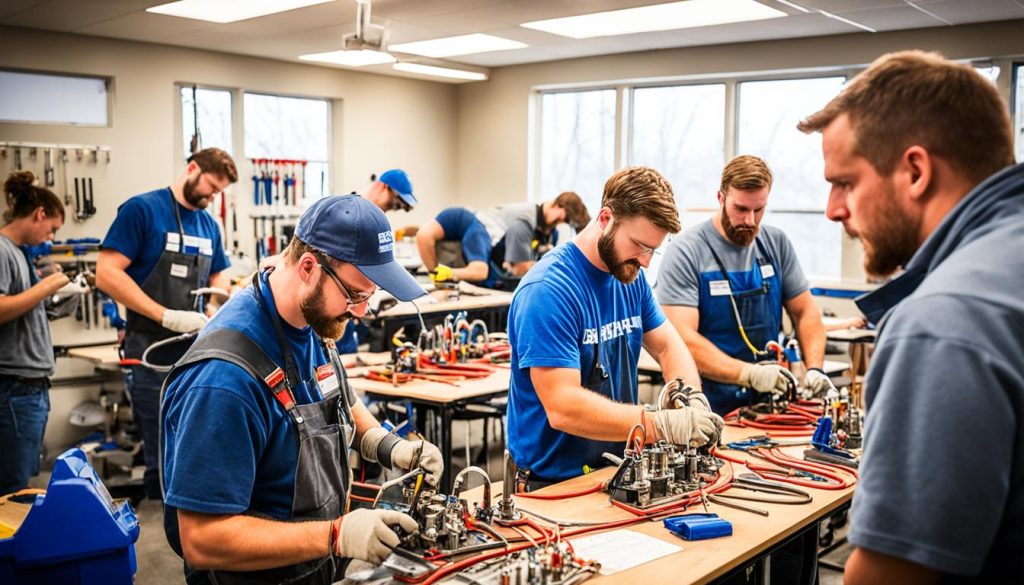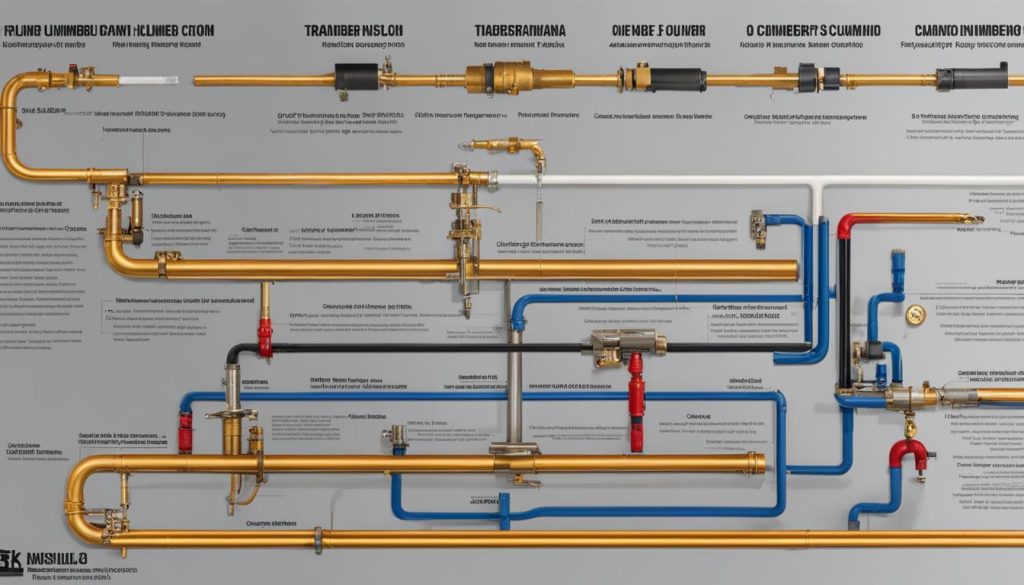Plumber Apprenticeship Duration: Know the Timeline
Did you know that becoming a certified plumber requires approximately five years of apprenticeship training? That’s right, aspiring plumbers in Ontario must undergo a comprehensive program that includes both on-the-job experience and in-school training.
During this rigorous training period, future plumbers accumulate 8,280 hours of on-the-job work experience and complete 720 hours of in-school training. The in-school training covers a wide range of topics, including workplace safety, pipe and fitting materials, plumbing fixtures, codes and regulations, drainage systems, and water distribution systems.
If you’re considering a career in plumbing, it’s important to understand the timeline and commitment involved. In this article, I’ll provide an overview of the plumber apprenticeship duration, on-the-job training, in-school training, and the certification process. Let’s dive in!
Key Takeaways:
- A plumber apprenticeship in Ontario typically lasts for approximately five years.
- It involves 8,280 hours of on-the-job work experience and 720 hours of in-school training.
- In-school training covers various topics related to plumbing, including workplace safety, pipe materials, plumbing fixtures, codes and regulations, drainage systems, and water distribution systems.
- Completing an apprenticeship program leads to a Certificate of Apprenticeship, and passing the certifying exam results in a Certificate of Qualification.
- Plumbing is a trade recognized under the Building Opportunities in the Skilled Trades Act and part of the Interprovincial Red Seal Program, providing national recognition for the trade.
On-the-Job Training for Plumbers
On-the-job training is a crucial component of a plumber apprenticeship, providing valuable work experience and practical skills development under the guidance of a skilled worker or trainer. During this phase, apprentices have the opportunity to apply the knowledge gained from their in-school training to real-world plumbing scenarios. Through hands-on experience, they gain a deeper understanding of the trade’s intricacies and become adept at solving plumbing challenges.
Under the mentorship of their sponsors or trainers, apprentices work alongside experienced plumbers, learning the trade’s best practices and honing their skills. This on-the-job training enables apprentices to acquire the necessary expertise to perform plumbing tasks efficiently and accurately.
Throughout the apprenticeship, the sponsor or trainer monitors the apprentice’s progress, ensuring they meet the required milestones and develop the essential skills mandated by the trade’s Apprenticeship Training Standard. This monitoring includes periodic assessments to gauge the apprentice’s competency and sign off on their mastery of plumbing techniques and procedures.
Through on-the-job training, plumber apprentices gain invaluable work experience, which prepares them for a successful career in the plumbing industry.
Apprenticeship Training Standard
| Skills and Competencies | Description |
|---|---|
| Installation and repair of plumbing systems | Apprentices learn to install and repair various plumbing systems, including water supply networks, drainage systems, and fixtures. |
| Pipe fitting and assembly | Apprentices gain expertise in pipe fitting and assembly, ensuring proper connections and leak-free installations. |
| Plumbing codes and regulations | Apprentices familiarize themselves with local plumbing codes and regulations to ensure compliance and safe practices. |
| Troubleshooting and problem-solving | Apprentices develop skills to diagnose and troubleshoot plumbing issues, employing effective problem-solving techniques. |
| Blueprint reading | Apprentices learn to interpret and analyze plumbing blueprints, understanding the layout and requirements of plumbing systems. |
| Customer service | Apprentices acquire customer service skills, emphasizing professionalism, effective communication, and client satisfaction. |
In-School Training for Plumbers
In-school training plays a vital role in the comprehensive plumber apprenticeship program, complementing the practical experience gained through on-the-job training. This segment focuses on the theoretical component of the training, which equips aspiring plumbers with the knowledge necessary for success in the field.
The in-school training for plumber apprenticeships in Ontario encompasses three levels of theoretical instruction. These levels provide a solid foundation in various essential aspects of plumbing, ensuring apprentices possess the necessary skills and understanding to excel in their future careers. Some of the key topics covered during the in-school training include:
- Workplace safety and regulations
- Selection and application of pipe and fitting materials
- Installation and maintenance of plumbing fixtures
- Understanding and adherence to plumbing codes and regulations
- Designing and implementing effective drainage systems
- Working with water distribution systems
- And more
The in-school training for plumber apprenticeships is designed to provide a comprehensive understanding of the plumbing trade, preparing apprentices to handle a wide range of tasks and challenges with confidence and expertise. The training delivery agency may offer various methods of course delivery, ensuring flexibility and accessibility for apprentices. These may include:
- Block release: Intensive training sessions held over a designated period
- Day release: Attending classes on specific days while continuing regular work during the week
- Part-time: Spreading out the training sessions over a more extended period
- Alternative delivery methods: Online or distance learning options
The tailored in-school training for plumber apprenticeships ensures that apprentices obtain the theoretical knowledge necessary to excel in their practical work, creating well-rounded and highly skilled professionals in the plumbing industry.
In-School Training Topics
| Topics Covered | Description |
|---|---|
| Workplace safety and regulations | Understanding and implementing safety protocols and industry regulations to ensure a secure work environment. |
| Selection and application of pipe and fitting materials | Identifying and utilizing the appropriate pipes and fittings for different plumbing systems and environments. |
| Installation and maintenance of plumbing fixtures | Learning how to install, repair, and maintain various plumbing fixtures, including faucets, toilets, and showers. |
| Understanding and adherence to plumbing codes and regulations | Familiarity with local and national plumbing codes and regulations to ensure compliance and safety standards. |
| Designing and implementing effective drainage systems | Creating efficient and effective drainage systems that meet the needs of residential, commercial, and industrial settings. |
| Working with water distribution systems | Understanding the design and installation of water distribution systems, ensuring proper flow and functionality. |
Certification and Trade Recognition for Plumbers
After successfully completing an apprenticeship program, aspiring plumbers receive a Certificate of Apprenticeship issued by the Ministry of Labour, Training and Skills Development in Ontario. This certificate serves as a recognition of the completion of the required training and work experience to become a certified plumber.
In order to practice plumbing legally in Ontario, individuals must possess either a Registered Training Agreement, Provisional Certificate of Qualification, or a Certificate of Qualification. These credentials ensure that plumbers have the necessary knowledge and skills to perform their duties safely and effectively.
The Certificate of Qualification is issued by Skilled Trades Ontario upon successfully passing the certifying exam. It validates the plumber’s expertise and competence in the trade and is a significant milestone in their career.
It is important to note that plumbing is a trade named under the Building Opportunities in the Skilled Trades Act. This legislation highlights the significance of skilled trades and provides regulations and standards to ensure the quality and safety of plumbing work. Furthermore, plumbing is part of the Interprovincial Red Seal Program, which offers nationwide recognition for the trade across Canada.
Benefits of Certification and Trade Recognition
Acquiring the necessary certifications and trade recognition offers numerous benefits to plumbers:
- Legitimacy: Holding a Certificate of Qualification demonstrates one’s commitment to professionalism and adherence to industry standards.
- Competitive Edge: The certification distinguishes certified plumbers from unqualified individuals, increasing their employability and business prospects.
- Client Confidence: Homeowners and businesses are more likely to trust certified plumbers due to their proven expertise and recognized qualifications.
- Continued Professional Development: Certification encourages ongoing learning and keeps plumbers updated with the latest industry practices and regulations.
| Certification | Requirements |
|---|---|
| Registered Training Agreement | An agreement between an apprentice, sponsor, and the Ministry of Labour, Training and Skills Development to commence apprentice training. |
| Provisional Certificate of Qualification | Granted to individuals with substantial plumbing experience but without a Certificate of Qualification. It permits them to work under supervision. |
| Certificate of Qualification | Issued upon successfully passing the certifying exam. It signifies full qualification to practice plumbing independently. |
Plumber Apprenticeship Timeline in British Columbia
In British Columbia, the plumber apprenticeship program is structured to span four years of training, with each year consisting of four 12-month periods. This structured timeline ensures apprentices go through a comprehensive and systematic learning process to build their skills and knowledge in the plumbing trade.
Throughout the apprenticeship, each year requires a minimum of 1560 hours of on-the-job training, allowing apprentices to gain practical experience under the guidance of experienced plumbing professionals. Alongside the on-the-job training, apprentices also undergo eight weeks of classroom instruction, providing them with the theoretical foundation necessary to excel in their chosen career.
The plumber apprenticeship program in British Columbia is divided into four distinct periods, each focusing on specific aspects of plumbing. These periods include topics such as workplace safety, metal fabrication, hydronic systems, heating systems, gas systems, and much more. Apprentices are required to pass each section of the course, demonstrating their proficiency in the subject matter, as well as successfully complete the AIT exam to progress in their apprenticeship education.
Cost and Funding for Plumber Apprenticeship
When considering a plumber apprenticeship in Alberta, it’s essential to understand the associated costs. On average, the total cost of a plumber apprenticeship is approximately $5,500, which includes tuition fees and additional expenses.
Alongside tuition fees, apprentices will also need to budget for books or modules, which can cost approximately $600 per period. Additionally, personal protective equipment (PPE) is a requirement for plumber apprentices and should be factored into the overall cost.
However, there are funding options available to aspiring plumbers in Alberta. The Southern Alberta Institute of Technology (SAIT) offers financial assistance to apprentices to help support their education. Additionally, federal funding programs are available to provide financial aid and resources for apprentices to assist with the costs of their apprenticeship.
Source Links
- https://www.sait.ca/apprenticeships-and-trades/programs/plumber
- https://www.skilledtradesontario.ca/trade-information/plumber/
- https://www.bcit.ca/programs/plumber-apprenticeship-full-time-4160appr/
- Investing Wisely: How Windows & Doors in Boost Property Value and Financial Health - April 24, 2025
- The Financial Impact of Personal Injuries: Why Legal Help Matters for Business Owners - April 16, 2025
- The Hidden Financial Costs of Domestic Assault: What Business Owners Need to Know - April 16, 2025













